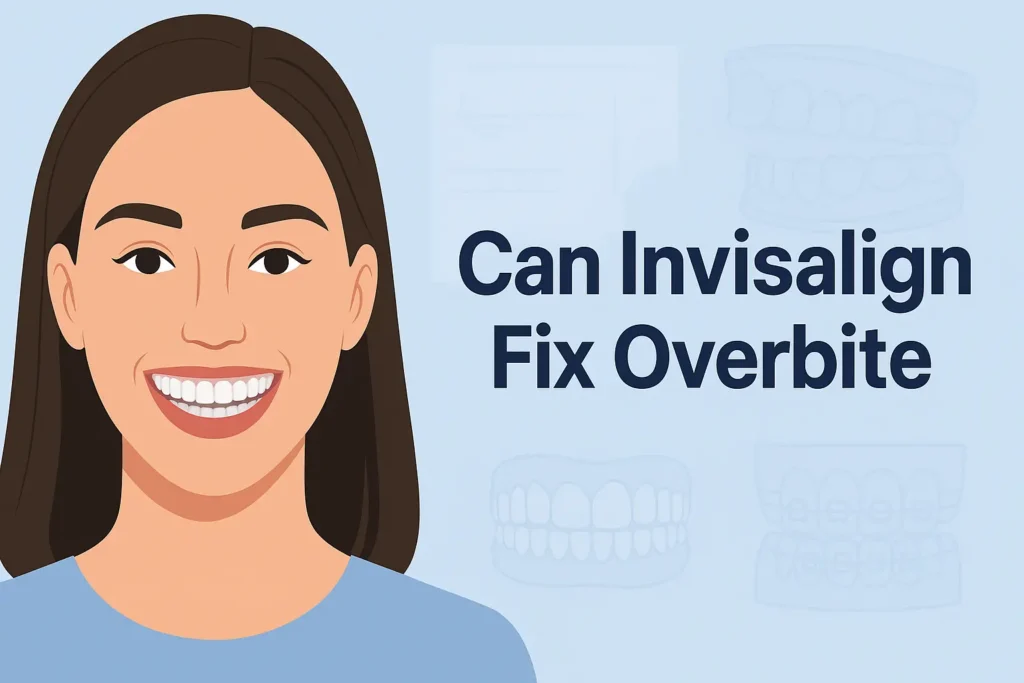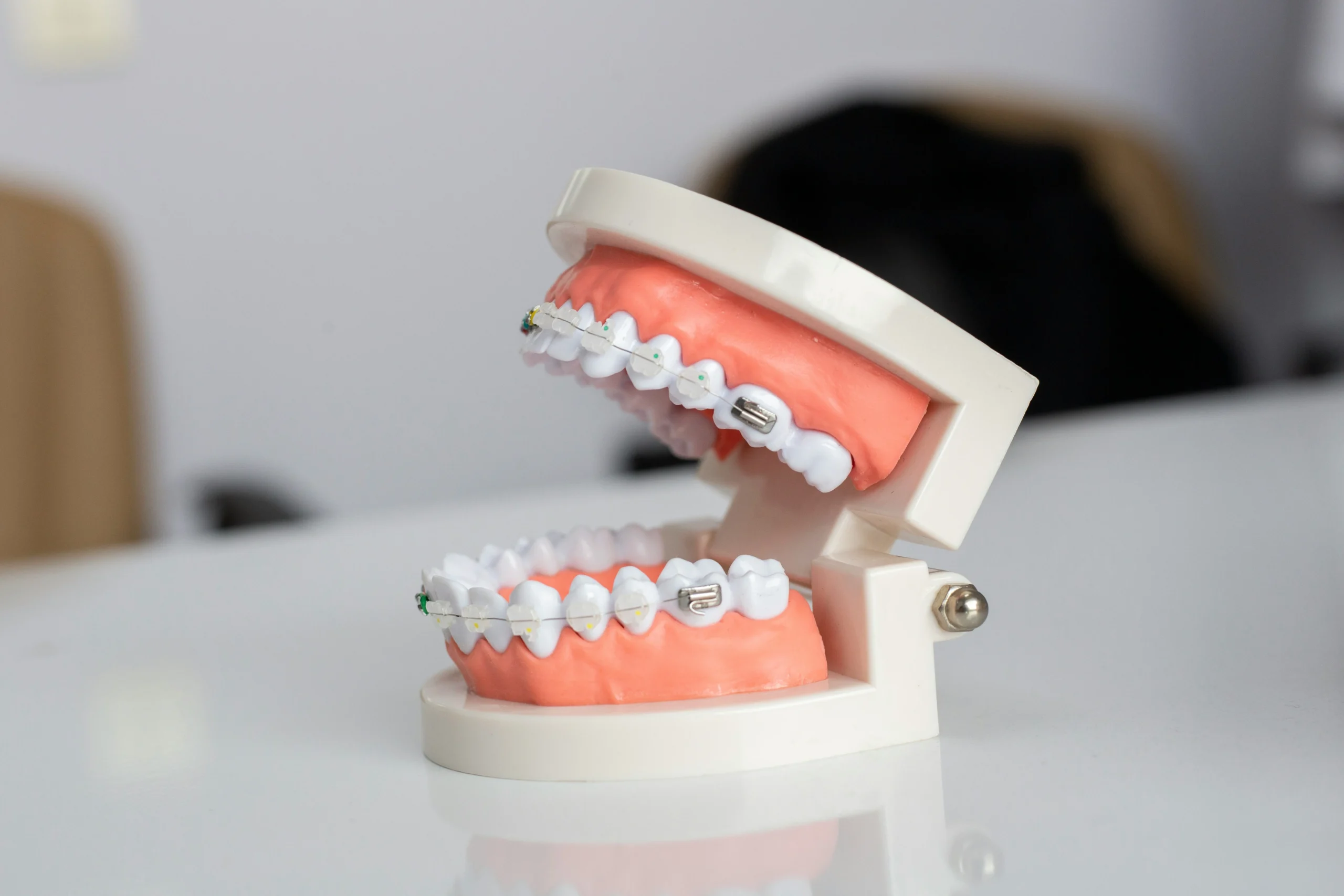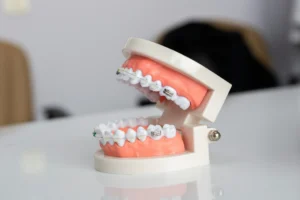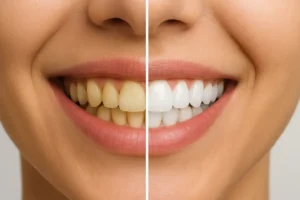Millions of people suffer from overbites, a common dental condition that affects both function and appearance. Many wonder: can Invisalign fix overbite?
The answer is yes — Invisalign can effectively treat most mild and moderate overbites, and sometimes even severe cases with additional techniques.
In this guide, we’ll break down what an overbite is, how Invisalign corrects it, how treatment time compares to braces, when Invisalign may not work, and real case studies from patients who’ve transformed their smilesWhat Is an Overbite?
An overbite is one of the most common dental alignment issues seen in both children and adults. It occurs when the upper front teeth overlap the lower front teeth more than normal. While a slight overlap is completely natural, a deep or excessive overbite can cause functional and aesthetic problems that affect a person’s bite, smile, and even jaw health. Many people who experience this condition wonder, “can Invisalign fix overbite?” — and understanding what causes an overbite is the first step to knowing how it can be corrected.

Causes of Overbite: Genetics, Habits, and Jaw Growth
The development of an overbite can be linked to a combination of genetic, behavioral, and growth-related factors.
- Genetics play a major role: the size and shape of your jaw and teeth are inherited traits that can lead to misalignment.
- Childhood habits, such as thumb sucking, tongue thrusting, or prolonged pacifier use, can push the teeth out of position and create a deep overbite.
- Jaw growth patterns during childhood and adolescence also influence the bite. If the upper jaw grows faster than the lower jaw, the upper teeth tend to protrude, resulting in an overbite.
Health Risks and Complications of Untreated Overbite
Leaving an overbite untreated can cause both dental and health complications over time.
- Tooth wear and enamel erosion occur because of the uneven pressure on teeth.
- Jaw strain and TMJ pain may develop due to misalignment of the bite.
- Gum recession and increased risk of tooth injury are also possible.
- In severe cases, an untreated overbite can alter facial aesthetics, making the lower face appear shorter or the chin less pronounced.
Different Types of Overbite (Dental vs. Skeletal)
Overbites are generally classified into two categories:
- Dental overbite, where the teeth themselves are misaligned, but the jaw structure is normal.
- Skeletal overbite, caused by the bones of the jaw being positioned incorrectly — often requiring more complex orthodontic treatment.
While traditional braces have long been used for correction, modern orthodontic solutions now offer discreet and effective alternatives. For many patients with dental overbites, the question “can Invisalign fix overbite?” has a positive answer — yes, Invisalign can realign the teeth and improve bite balance in most mild to moderate cases, providing a healthier and more confident smile.
How Invisalign Corrects an Overbite
The Invisalign system has transformed modern orthodontics by offering a clear, comfortable, and effective way to correct bite problems. One of the most common questions patients ask is: “can Invisalign fix overbite?” The answer is yes — Invisalign can successfully treat many cases of mild to moderate overbites, and even some severe ones with additional techniques. Understanding how Invisalign works step-by-step helps explain why it’s such a powerful alternative to traditional braces.
Step-by-Step Process of Invisalign Treatment
The treatment begins with a 3D digital scan of the patient’s teeth and bite. This allows the orthodontist to create a personalized plan showing how each tooth will move over time. The patient then receives a series of custom-made clear aligners, each designed to apply gentle and precise pressure to specific teeth.
- Step 1: Digital planning – mapping the exact tooth movements needed.
- Step 2: Wearing the aligners – typically 20–22 hours per day, switching to a new set every 1–2 weeks.
- Step 3: Monitoring progress – regular dental checkups ensure the bite is improving as planned.
Over time, these small, controlled movements gradually shift the teeth and jaw into their ideal position, helping to reduce or eliminate the overbite.
The Role of Attachments, Aligners, and Precision Wings
To enhance results, Invisalign often uses small, tooth-colored attachments that help the aligners grip and move teeth more efficiently. In cases where the jaw position needs adjustment, precision wings — tiny extensions built into the aligners — gently guide the lower jaw forward, improving bite alignment. These advanced design features make Invisalign highly effective for overbite correction while remaining nearly invisible.
Differences Between Correcting Mild, Moderate, and Severe Overbites
- Mild overbite: often resolved in 8–12 months with standard aligners.
- Moderate overbite: may require 12–18 months of treatment, including attachments and elastics.
- Severe overbite: may take 18–24 months or need combination therapy (e.g., Invisalign plus orthodontic appliances or surgery).
While treatment duration varies, the process is typically shorter and more comfortable than braces. For many patients, the results clearly prove that Invisalign can fix overbite effectively — aligning teeth, balancing the bite, and restoring confidence with a natural, healthy smile.
Treatment time vs. braces
Average treatment length with Invisalign vs. braces
When considering Invisalign for overbite correction, many patients wonder how long the treatment will take compared to traditional braces. On average, mild to moderate overbites can be corrected with Invisalign within 12 to 18 months, whereas traditional braces may require 18 to 24 months depending on the complexity of the case. Invisalign uses a series of clear, removable aligners that gradually shift teeth into proper alignment. This system allows for more predictable movements in some cases and can often reduce overall treatment time if the patient follows the prescribed schedule. However, severe or complex overbite cases may still take as long as braces or even longer. Compliance with wearing Invisalign aligners for at least 20-22 hours a day is critical; any lapse can extend treatment duration significantly. Traditional braces, on the other hand, are fixed appliances, which means teeth move continuously without relying on patient compliance, but adjustments are needed periodically. Additionally, factors such as age, dental history, and severity of misalignment play a major role in how quickly results are achieved. Adults may experience slightly longer treatment times due to denser bone structures, while teenagers often respond more quickly. Overall, both Invisalign and braces can effectively correct overbites, but the speed of treatment largely depends on patient cooperation and the specific case details. Understanding these factors can help patients make informed decisions about which treatment option is right for them.
Factors that affect treatment duration (age, severity, compliance)
Several key factors influence how long Invisalign treatment will take for overbite correction. Age is an important consideration, as younger patients generally experience faster tooth movement due to more flexible bone structures. Adults, in contrast, may require more time, especially for severe overbite cases. The severity of the overbite itself also impacts duration: mild cases often respond quickly, while moderate or severe overbites may need additional aligners or attachments to achieve proper alignment. Compliance is another critical factor; Invisalign aligners must be worn consistently for 20-22 hours per day to ensure efficient progress. Patients who remove aligners too frequently or fail to follow their dentist’s instructions can experience delays, and in some cases, regression. Lifestyle factors such as eating habits, oral hygiene, and regular check-ups also influence treatment efficiency. Proper care of aligners and adherence to a structured schedule contribute to more predictable outcomes. Ultimately, the combination of age, severity, and patient dedication determines how long it will take to correct an overbite with Invisalign.
Pros and cons of Invisalign compared to traditional braces
Invisalign offers numerous advantages over traditional braces. Its clear aligners are nearly invisible, providing a cosmetic benefit that appeals to adults and teens. The removable design allows for easier oral hygiene, meaning patients can brush and floss normally, reducing the risk of cavities and gum issues. Invisalign is also more comfortable, with fewer sharp edges and less irritation to the cheeks and gums. On the downside, Invisalign relies heavily on patient compliance. Skipping hours or losing aligners can delay treatment. It may also be less effective for severe dental issues such as major overbites, crowding, or misaligned jaws. Traditional braces, while more visible, provide continuous correction and can address complex dental problems more predictably. They are also less dependent on patient behavior for successful outcomes. Each method has trade-offs: Invisalign prioritizes aesthetics and comfort but requires discipline, while braces are more robust for complicated cases but come with increased maintenance challenges. Choosing the right approach depends on the individual’s dental condition, lifestyle, and treatment goals.
When Invisalign may not work
Severe skeletal overbite cases that need surgery
Invisalign is effective for many dental misalignments, but severe skeletal overbites caused by jaw discrepancies often require surgical intervention. These cases involve the bone structure of the upper and lower jaw rather than just the teeth, which aligners alone cannot correct. Without surgery, Invisalign may only partially improve appearance but fail to achieve proper bite function. Orthognathic surgery is sometimes combined with aligners or braces to correct jaw position and ensure long-term results. Patients considering Invisalign should consult with an orthodontist to evaluate skeletal involvement. Advanced imaging and bite analysis can determine if surgical intervention is necessary. Recognizing these limitations helps prevent patient frustration and sets realistic expectations.
Situations requiring traditional braces or hybrid treatments
Certain overbite cases benefit from hybrid treatments combining Invisalign and traditional braces. Complex misalignments, rotated teeth, or severely crowded arches may need braces to achieve precise tooth movement. Attachments, elastics, or auxiliary appliances can be used with aligners, creating a flexible yet comprehensive approach. Hybrid treatments are especially useful for patients seeking aesthetic benefits of Invisalign while addressing structural or severe orthodontic challenges. Choosing the right strategy ensures optimal results in shorter treatment times and maintains oral health.
Patient compliance and lifestyle factors limiting Invisalign success
Invisalign’s effectiveness depends heavily on patient behavior. Skipping wear hours, improper aligner handling, or inconsistent dental visits can limit results. Lifestyle factors such as frequent snacking, smoking, or poor oral hygiene also affect outcomes. Unlike braces, aligners can be removed, which offers convenience but requires responsibility. Patients must understand the importance of wearing aligners consistently to avoid prolonged treatment or suboptimal results.
Case studies and patient experiences
Success story: mild overbite corrected with Invisalign
Many mild overbite cases respond exceptionally well to Invisalign. A typical example involves a patient with a slight overbite who wore aligners diligently for 14 months. Gradual adjustments corrected the bite without the discomfort or visibility associated with braces. Regular check-ups ensured that progress stayed on track, resulting in a healthy, aesthetically pleasing smile. Patient compliance and proper follow-up were crucial for success.
Moderate overbite with attachments and elastics
In moderate overbite cases, Invisalign alone may not suffice. Using attachments and elastics can enhance tooth movement and achieve the desired alignment. Patients following this approach often experience noticeable improvements within 18-20 months. The combination allows aligners to handle tooth positioning while elastics guide bite correction effectively.
Severe overbite case requiring combined treatment approaches
Severe overbite cases sometimes require a combination of Invisalign, braces, and even surgical intervention. A patient with a deep bite and jaw misalignment benefited from a hybrid approach: braces for precise control, Invisalign for aesthetics during initial alignment, and orthognathic surgery for skeletal correction. This multi-step treatment resulted in both functional and cosmetic improvement, highlighting the importance of individualized planning for complex cases.
Summary
In conclusion, Invisalign can be an effective solution for correcting mild to moderate overbites, offering the benefits of clear, removable aligners and a more comfortable treatment experience compared to traditional braces. However, its success largely depends on patient compliance and the severity of the overbite. Severe skeletal overbites or complex dental issues may require hybrid treatments or surgical interventions for optimal results. By consulting with an experienced orthodontist and adhering to treatment guidelines, patients can achieve significant improvements in both function and aesthetics, enjoying a healthier, more confident smile.







